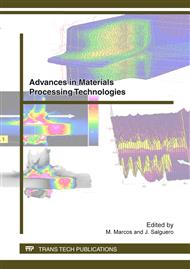p.157
p.163
p.169
p.177
p.183
p.189
p.195
p.201
p.207
Modeling and Simulation of Vibration-Assisted Extrusion Tapping of Internal Thread with Finite Element Method (FEM)
Abstract:
This paper firstly introduces the principle and characteristic of traditional extrusion tapping of internal thread, elaborates the material flow law during tapping process. Then puts forward a novel process of vibration-assisted extrusion tapping of internal thread, explains the effect mechanism of vibration during extrusion tapping of internal thread. Finally, with the finite element method (FEM), the simplified model of extrusion tapping are built, and the simulation of thread forming process of traditional extrusion tapping of internal thread are conducted, furthermore, the characteristic and influencing law of different vibration parameters (include vibration frequency, amplitude and direction) of vibration-assisted extrusion tapping of internal thread are studied, and some practical results are obtained. The simulation results show that applying vibration to extrusion tapping of internal thread can reduce tapping torque and improve thread forming quality, the reasonable selection of vibration parameters are very crucial to this novel process.
Info:
Periodical:
Pages:
183-188
Citation:
Online since:
April 2012
Authors:
Price:
Сopyright:
© 2012 Trans Tech Publications Ltd. All Rights Reserved
Share:
Citation:


